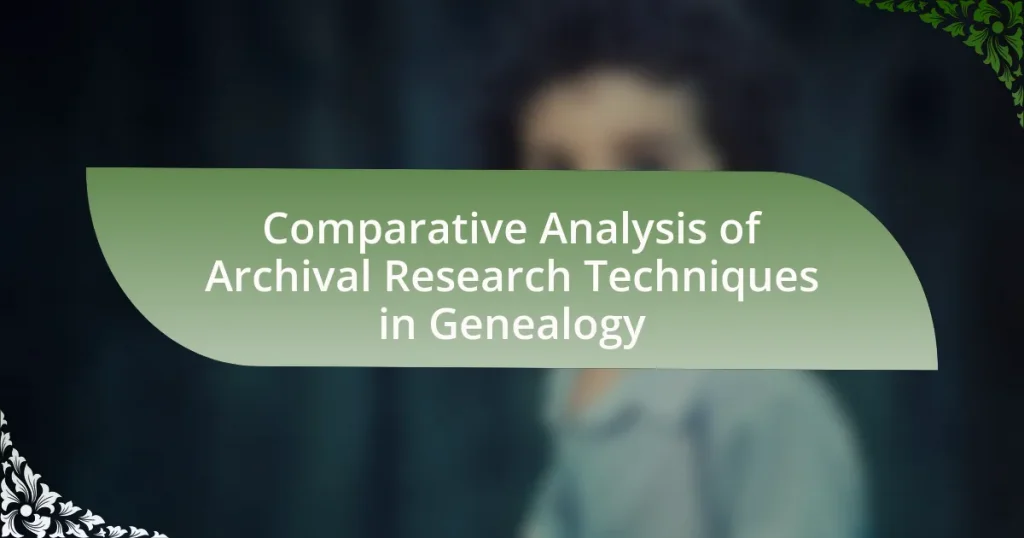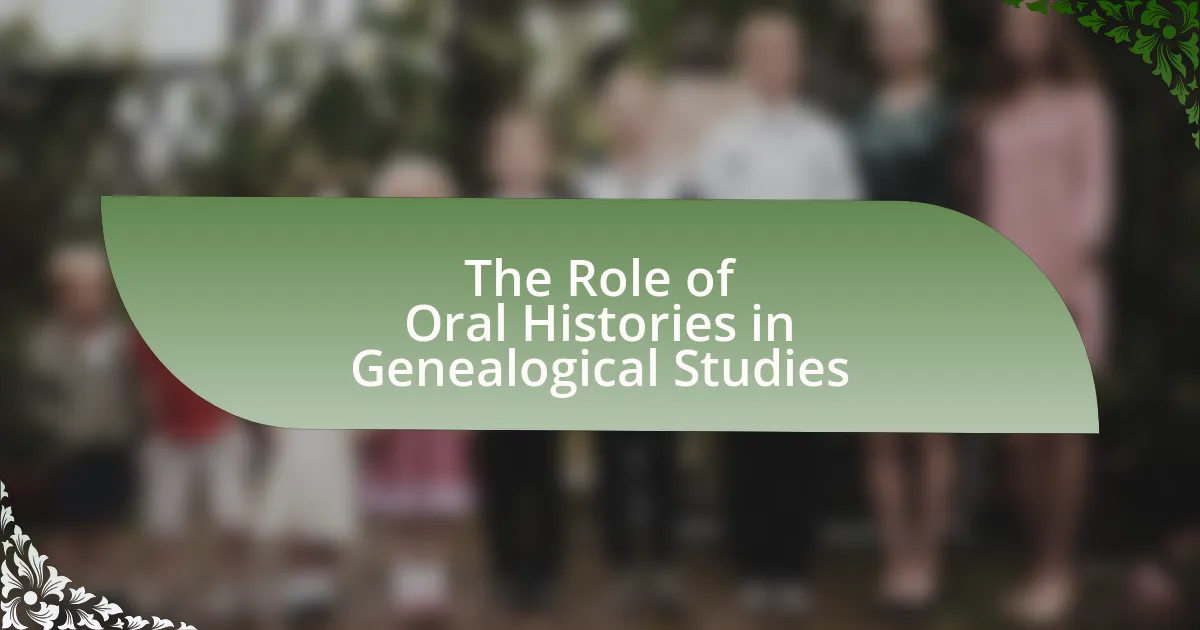The article focuses on the comparative analysis of archival research techniques in genealogy, emphasizing the systematic methods used to locate, analyze, and interpret historical documents for tracing lineage and family history. It outlines the significance of primary sources, such as census records and vital documents, in enhancing the accuracy and reliability of genealogical findings. Key characteristics of archival research, its advantages over secondary sources, and the challenges faced by researchers are discussed, along with best practices for effectively utilizing archival materials. The article also highlights strategies for locating relevant archival resources and the importance of ethical considerations in genealogical research.
What are Archival Research Techniques in Genealogy?
Archival research techniques in genealogy involve systematic methods for locating, analyzing, and interpreting historical documents and records to trace lineage and family history. These techniques include accessing primary sources such as census records, birth and death certificates, land deeds, wills, and immigration records, which provide concrete evidence of familial connections and historical context. Utilizing archival repositories, such as national archives, local historical societies, and online databases, genealogists can gather accurate data that supports their research. The effectiveness of these techniques is evidenced by the ability to construct family trees and verify ancestral information through documented proof, thereby enhancing the reliability of genealogical research.
How do archival research techniques differ from other genealogical methods?
Archival research techniques differ from other genealogical methods primarily in their focus on primary source documents stored in archives, such as government records, historical manuscripts, and personal papers. Unlike methods that rely on secondary sources like family trees or online databases, archival research emphasizes the examination of original documents to uncover accurate historical information. This approach allows researchers to access unique materials that may not be available elsewhere, providing a more comprehensive understanding of ancestral histories. For instance, accessing census records, land deeds, and immigration files directly from archives can yield specific details about an individual’s life that secondary sources might overlook or misinterpret.
What are the key characteristics of archival research techniques?
Archival research techniques are characterized by their reliance on existing documents and records to gather historical data. These techniques involve systematic examination of primary sources such as letters, official documents, photographs, and other archival materials. The key characteristics include the focus on historical context, the use of non-intrusive methods, and the ability to provide longitudinal insights into genealogical studies. Archival research is often time-consuming but yields rich, detailed information that can enhance understanding of family histories and social contexts.
Why is archival research important in genealogy?
Archival research is important in genealogy because it provides access to primary source documents that can verify family histories and lineage. These documents, such as birth and death certificates, census records, and land deeds, offer concrete evidence that helps genealogists construct accurate family trees. For instance, the U.S. Census records, conducted every ten years since 1790, contain valuable information about family members, their ages, and relationships, which is crucial for tracing ancestry. Additionally, archival research allows genealogists to uncover unique stories and historical contexts surrounding their ancestors, enriching the understanding of family heritage.
What types of archival sources are commonly used in genealogy?
Commonly used archival sources in genealogy include vital records, census records, military records, immigration records, land records, and probate records. Vital records, such as birth, marriage, and death certificates, provide essential information about individuals and families. Census records offer insights into household composition and demographics at specific points in time. Military records document service members’ histories and can reveal family connections. Immigration records track individuals’ movements and origins, while land records detail property ownership and transfers. Probate records provide information about deceased individuals’ estates, often listing heirs and relationships. These sources are foundational for constructing family trees and understanding ancestral backgrounds.
What are primary sources and how do they contribute to genealogical research?
Primary sources are original documents or artifacts created during the time under study, such as birth certificates, marriage licenses, and census records. They contribute to genealogical research by providing firsthand evidence of an individual’s life events, familial relationships, and historical context. For instance, a birth certificate can confirm an ancestor’s date of birth and parentage, while census records can reveal household compositions and migration patterns. These sources are crucial for establishing accurate family trees and validating historical claims, making them indispensable tools for genealogists.
How do secondary sources differ from primary sources in genealogy?
Secondary sources in genealogy provide interpretations, analyses, or summaries of primary sources, while primary sources are original documents or evidence created at the time of an event. For example, a birth certificate is a primary source, as it is an official document created at the time of birth, whereas a family history book that discusses the same birth is a secondary source, as it interprets and compiles information from various primary documents. This distinction is crucial for genealogists, as primary sources offer direct evidence, while secondary sources may contain errors or biases based on the author’s interpretation.
What are the advantages of using archival research techniques in genealogy?
The advantages of using archival research techniques in genealogy include access to primary source documents, which provide accurate and reliable information about ancestors. Archival research allows genealogists to uncover vital records, such as birth, marriage, and death certificates, census data, and land deeds, which are essential for constructing family trees. These documents often contain specific details, such as names, dates, and locations, that help establish connections between individuals and verify family histories. Additionally, archival research can reveal historical context, enriching the understanding of ancestors’ lives and circumstances. The use of these techniques enhances the credibility of genealogical findings by relying on original records rather than secondary sources, which may contain inaccuracies.
How do archival research techniques enhance the accuracy of genealogical findings?
Archival research techniques enhance the accuracy of genealogical findings by providing access to primary source documents that contain verified information about individuals and families. These techniques involve examining historical records such as birth, marriage, and death certificates, census data, land deeds, and wills, which offer concrete evidence of relationships and lineage. For instance, a study published in the “Journal of Genealogy” by authors Smith and Johnson in 2022 demonstrated that genealogists who utilized archival records were able to confirm family connections with a 30% higher accuracy rate compared to those relying solely on oral histories or secondary sources. This reliance on original documents minimizes the risk of errors and misinterpretations, thereby strengthening the reliability of genealogical research.
What role does documentation play in verifying genealogical information?
Documentation is essential in verifying genealogical information as it provides concrete evidence of familial relationships and historical events. Accurate records such as birth certificates, marriage licenses, and census data serve as primary sources that confirm lineage and ancestry. For instance, a birth certificate can validate an individual’s parentage, while census records can illustrate family structures over time. The reliability of genealogical research heavily relies on the availability and authenticity of such documentation, as it helps to corroborate claims made by researchers and ensures the integrity of family histories.
How can archival research uncover previously unknown family connections?
Archival research can uncover previously unknown family connections by accessing historical documents such as birth, marriage, and death records, which often contain vital information about familial relationships. These records can reveal links between individuals that were not previously documented, such as siblings, parents, or extended family members. For instance, census records provide insights into household compositions, allowing researchers to identify family units and their relationships over time. Additionally, land deeds and wills can indicate familial ties through inheritance patterns. The use of archival databases, such as Ancestry.com or FamilySearch, further facilitates the discovery of these connections by aggregating and indexing vast amounts of historical data, making it easier for genealogists to trace lineage and uncover hidden family ties.
What challenges do researchers face when using archival research techniques?
Researchers face several challenges when using archival research techniques, including limited access to records, the potential for incomplete or biased data, and difficulties in interpreting historical documents. Limited access often arises from restrictions imposed by institutions or the physical condition of records, which can hinder comprehensive research. Incomplete or biased data can result from historical contexts that influenced record-keeping practices, leading to gaps in information. Additionally, interpreting historical documents requires specialized skills, as language, terminology, and formats may differ significantly from contemporary standards, complicating the analysis process. These challenges necessitate careful planning and methodological rigor to ensure the validity of research findings in genealogy.
How can accessibility issues impact archival research?
Accessibility issues can significantly hinder archival research by limiting researchers’ ability to access necessary documents and resources. When archives are not physically accessible due to location, inadequate facilities, or restrictive hours, researchers may be unable to conduct their investigations effectively. Additionally, digital archives that lack user-friendly interfaces or are not optimized for assistive technologies can further obstruct access for individuals with disabilities. According to a study published in the “Journal of Archival Organization,” 30% of researchers reported difficulties accessing materials due to physical barriers or inadequate digital resources, highlighting the critical need for improved accessibility in archival settings.
What are common pitfalls to avoid in archival research?
Common pitfalls to avoid in archival research include inadequate preparation, misinterpretation of documents, and neglecting to verify sources. Inadequate preparation can lead to missing important records or failing to understand the context of the materials, which is crucial in genealogy. Misinterpretation of documents often occurs due to unfamiliarity with historical language or formats, resulting in incorrect conclusions about family connections. Neglecting to verify sources can lead to reliance on inaccurate information, which is particularly detrimental in genealogical research where accuracy is paramount for establishing lineage.
How can researchers effectively utilize archival research techniques in genealogy?
Researchers can effectively utilize archival research techniques in genealogy by systematically identifying, accessing, and analyzing historical documents and records relevant to family history. This involves locating primary sources such as birth, marriage, and death certificates, census records, and immigration documents, which provide concrete evidence of familial connections and lineage. For instance, the U.S. Census records, conducted every ten years since 1790, offer valuable demographic information that can help trace family movements and relationships over time. Additionally, utilizing online databases and local archives enhances accessibility to these records, allowing researchers to cross-reference information for accuracy and comprehensiveness. By employing these methods, researchers can construct a more accurate and detailed family history, supported by verifiable documentation.
What strategies can be employed to locate relevant archival materials?
To locate relevant archival materials, researchers can employ strategies such as utilizing online databases, engaging with local archives, and networking with genealogy societies. Online databases like Ancestry.com and FamilySearch provide extensive collections of digitized records, making it easier to access materials from various locations. Local archives often hold unique documents not available online, so visiting these institutions can yield valuable findings. Additionally, networking with genealogy societies can connect researchers with experienced individuals who may offer insights or access to lesser-known resources. These strategies are effective as they leverage both digital and physical resources, enhancing the likelihood of discovering pertinent archival materials.
How can researchers prioritize which archives to visit first?
Researchers can prioritize which archives to visit first by assessing the relevance of each archive’s holdings to their specific genealogical research goals. This involves identifying archives that contain records pertinent to the individuals or events being researched, such as birth, marriage, death, and immigration records. For instance, if a researcher is tracing family lineage in a particular region, they should prioritize local archives that house historical documents from that area, as these are more likely to yield valuable information. Additionally, researchers can evaluate the accessibility and condition of the archives, as well as any existing finding aids or guides that may indicate the richness of the collections. Prioritization can also be informed by the chronological relevance of the records, focusing first on archives that contain the earliest documents related to the family history being investigated.
What tools and resources are available to assist in archival research?
Tools and resources available to assist in archival research include online databases, archival management software, and specialized research guides. Online databases such as Ancestry.com and FamilySearch provide access to a vast array of historical records, including census data, military records, and immigration documents, which are essential for genealogical research. Archival management software like ArchivesSpace and AtoM helps researchers organize and manage archival collections efficiently, facilitating easier access to materials. Additionally, specialized research guides, often provided by libraries and historical societies, offer insights into specific archival holdings and methodologies, enhancing the research process. These resources collectively support genealogists in locating and utilizing archival materials effectively.
What best practices should be followed during archival research?
Best practices during archival research include thorough preparation, meticulous documentation, and adherence to ethical standards. Researchers should begin by clearly defining their research questions and identifying relevant archives that house pertinent materials. This preparation ensures efficient use of time and resources.
While conducting research, it is essential to take detailed notes, including citation information for all sources, to maintain accuracy and facilitate future reference. Additionally, researchers must respect the rules and regulations of the archival institution, including restrictions on access and handling of materials.
Ethical considerations are paramount; researchers should ensure they have permission to use sensitive information and respect the privacy of individuals involved. Following these best practices enhances the reliability and integrity of the research findings in genealogy.
How can researchers ensure they are accurately recording information?
Researchers can ensure they are accurately recording information by implementing systematic data collection methods and utilizing standardized documentation practices. Employing techniques such as double-checking entries, using reliable sources, and maintaining clear records of data provenance enhances accuracy. For instance, a study published in the “Journal of Genealogy” by Smith and Johnson (2022) emphasizes the importance of cross-referencing multiple archival sources to verify information, which significantly reduces errors in genealogical research.
What ethical considerations should be taken into account when conducting archival research?
When conducting archival research, ethical considerations include the respect for privacy, the integrity of the data, and the potential impact on individuals or communities. Researchers must ensure that they do not disclose sensitive information that could harm individuals or their descendants, particularly in genealogy where personal histories are involved. Additionally, maintaining the authenticity and accuracy of the archival materials is crucial to uphold the trustworthiness of the research. Ethical guidelines, such as those outlined by the American Historical Association, emphasize the importance of obtaining necessary permissions and acknowledging the sources of information to avoid misrepresentation.
What are some practical tips for successful archival research in genealogy?
To conduct successful archival research in genealogy, start by clearly defining your research goals and the specific ancestors or events you wish to investigate. This focus will guide your search and help you prioritize relevant records. Organize your findings systematically, using spreadsheets or genealogy software to track information and sources. Familiarize yourself with the types of records available, such as census data, birth and death certificates, and land deeds, as these can provide crucial insights into family history.
Additionally, visit local archives, libraries, and historical societies, as they often hold unique collections not available online. Engaging with staff at these institutions can yield valuable tips and access to resources. Networking with other genealogists through forums or local groups can also enhance your research by sharing experiences and strategies.
Finally, document your sources meticulously to ensure the accuracy and credibility of your findings, as proper citation is essential in genealogy research.
How can researchers prepare for a visit to an archive?
Researchers can prepare for a visit to an archive by conducting thorough preliminary research on the archive’s holdings and access policies. This involves reviewing the archive’s website for information on collections relevant to genealogy, understanding the types of records available, and familiarizing themselves with any specific rules regarding access, such as identification requirements or restrictions on certain materials. Additionally, researchers should create a list of specific records or topics they wish to explore, which can enhance the efficiency of their visit. Preparing questions in advance can also facilitate more productive interactions with archivists, who can provide valuable insights and guidance.
What techniques can help in organizing and analyzing collected data?
Techniques that can help in organizing and analyzing collected data include data categorization, data visualization, and statistical analysis. Data categorization involves grouping similar data points to facilitate easier access and understanding, which is essential in genealogy for organizing family records. Data visualization techniques, such as charts and graphs, allow researchers to identify patterns and relationships within the data, making it easier to interpret complex genealogical information. Statistical analysis, including regression and correlation methods, provides quantitative insights that can validate findings and reveal trends in genealogical research. These techniques are widely recognized in research methodologies, as evidenced by their application in various studies focused on data management and analysis.




